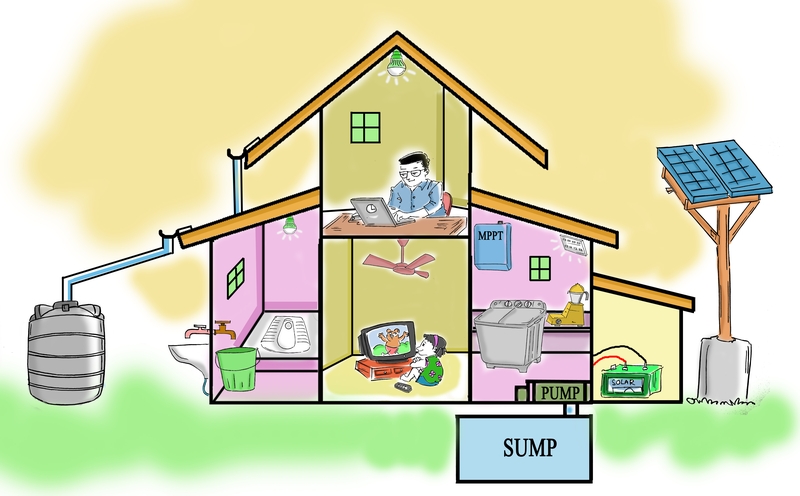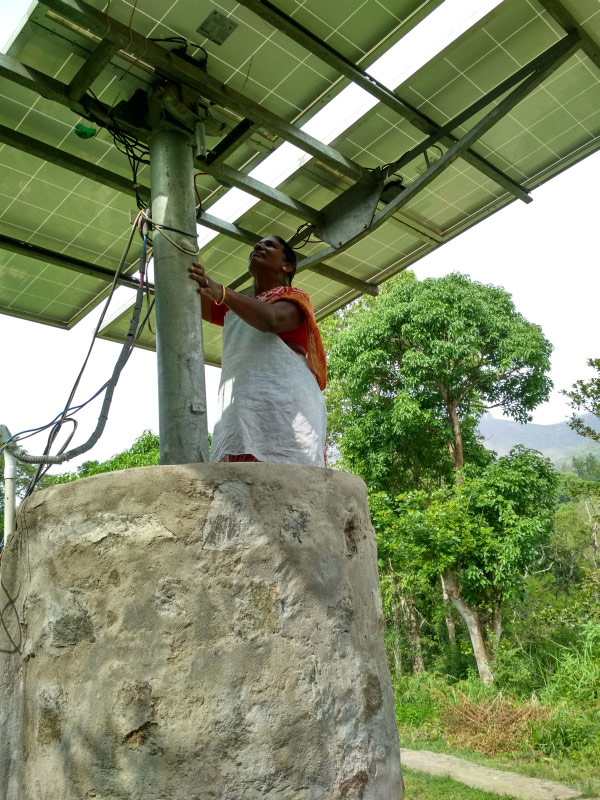|
(This is the first in a series of articles. The second in the series will be on: Plastic.)

It is generally acknowledged that Global Warming or Climate Change is causing "Extreme Weather", most recently: in 2018, the floods in Kerala, in Chennai in 2015, in Kashmir in 2014 and Uttarakhand in 2013.
What can I as an individual do about it? First we need to understand the problem.
Greenhouse Gases:
Most Sensible Scientists agree that Global Warming is caused by an increase of Greenhouse Gases.
Namely:
- Carbon dioxide: mostly from fossil fuel combustion.
- Methane: mostly from cattle "farts", rice paddies, swamps and tundra.
- Chlorofluorocarbons (CFCs): mostly from Refrigerators, Air Conditioning and plastic foams.
- Nitrous Oxide mostly from Fertilizer use and Fossil Fuel Combustion.
- Ozone: mostly from reactions involving pollutants.
Carbon dioxide is the biggest culprit, but CFCs are 10,000 times more "effective" in causing Global Warming.
So from this information we can understand that the burning of Fossil Fuels in Electric Power Stations, in cars, in locomotives, in lorries, in aeroplanes and large sea-going ships, must be reduced as much as possible and as soon as possible.
Solar Photo-Voltaic (SPV) electric panels and large wind generators are increasingly being set up in various locations in India to produce electricity for the grid. Even better if SPV panels and wind generators are decentralized. That means they provide electricity for a particular local purpose, such as for a school, a college, a factory or our own houses. This is happening here and there, but could happen much more; because, when electricity is transmitted over long distances much of it is lost "in transmission."
Decentralized Energy Production is best:
Bear in mind that Non-renewable Oil and Coal-fired Electric Power Stations are highly polluting, so the sooner we have Renewables such as SPV and wind generators, the better. In the absence of bright Sun and Wind, nowadays there are many modern technologies for the storage of electricity.
All these technologies can be described as Appropriate Technologies and since there is sense in not "keeping all your eggs in one basket," you may be interested to know that James Lovelock, known as the father of the Green Movement, is in favour of well-managed Nuclear Power. But not all scientists would agree with him, especially in India, where we have so much sun and in certain locations plenty of wind too.
Appropriate Technologies?
We are given many pieces of advice: "Take public transport. Switch off the lights. Don't waste water", etc. , but what is more seriously required is for us human beings to understand that although technologies are clever and often beautiful, they also require the Mining of precious minerals of Planet Earth and plenty of Energy in their creation and use. Then, they almost always produce pollution of one kind or another, when used.
We need to be more critical and decide which technologies are kind to Nature, the Planet and all beings and which we need to avoid as much as possible. We can discuss and have different points of view but surely it is very important to realise that Appropriate Technologies are a Very Good Idea. In future articles, we will explore many different Appropriate Technologies that will do least harm to Planet Earth and all her Beings.
But what about Me in my House, What can I Do?
Check every electrical appliance in your house. What is its consumption in Watts? Nowadays one can buy 7 watt LED bulbs, I am writing by the light of one 9 watt bulb hanging from the roof above me. For bathrooms and corridors, a 5 or 7 watt bulb is sufficient.
Work out how many hours each day you use each appliance so you may end up with a table like so:
| Item/Location |
Wattage |
Time |
Watt-hours |
| Light: Bedroom. |
9W |
½ hour |
4 ½ Wh |
| Light: Hall and Kitchen. |
9W |
3 ½ hour |
31 ½ Wh |
| Light: Bathroom, Toilet, Corridor. |
5W |
Total 1 hour |
5 Wh |
| Water Pump ½ HP. |
375W |
20 minutes |
124 Wh |
| T.V. |
30W |
2 hours |
60 Wh |
| Fridge. |
36W |
15 hours |
540 Wh |
| Fan. |
70W |
8 hours |
560 Wh |
| Laptop. |
30W |
2 hours charging |
60 Wh |
| Washing Machine: Twin Tub. |
350W |
½ hour |
175 Wh |
| Mixi |
600W |
10 minutes |
100 Wh |
| 3 Mobiles |
5W |
4 hours charging |
60 Wh |
| Total Consumed per day |
1720 Wh |
I have recently modified this table, e.g. modern fridges consume much less electricity. In general most modern appliances are becoming more efficient. From your point of view, you must be abstemious in your consumption of electricity. Then your batteries and solar system will last for many years to come.
Monthly you can check the batteries, that they are clean and do not have vedigree on the terminals. Top them up with good quality distilled water, when necessary. Most likely that will be the only maintenance necessary.
Just a minute, you may ask, "What is a watt?" A Watt is a measurement of electrical consumption. Multiply: Volts x Amps = Watts.
VA = W.
So if your water pump is ½ Horse Power (1 HP=746 watts) the pump consumes: 373 watts. If it runs for 20 minutes a day, it consumes:
373 x 20 ÷ 60 watt-hours = 124 Wh.
Got it?
You may have other appliances that you need to use. Check the 'Wattage' on the back plate and try to limit your overall consumption to less than 2000Wh (2KWh).

Rathinam, a Kitchen Lady, tilting the panels to face the Sun, 3 times a day.
 The Cost ?!
The Cost ?!
Well, now you are going to ask me what will all this cost?!
I consulted the experts: Subhash and Jigar. They tell me you will need 4 nos. Solar Photo-Voltaic electric panels of 240 Watts each. They cost approximately Rs. 11,000 each, so 4 SPV panels will cost Rs. 44,000. They will deliver: 4 x 240 = 960 Watts. You can expect on average the equivalent of 5 hours of peak sunshine per day. So that is approximately 4800 watt-hours or 4.8 kilowatt-hours per day.
Don't start comparing solar electricity with consumption of electricity at home! Why? Because you are going to be abstemious ! Why? Because in that way your batteries will last for many years to come. Some of our batteries lasted for 11 years.
When we began Sholai School we had 4 SPV panels of 35 watts each. Yes! Just 35 Watts and 2 jeep batteries. We used our SPV system to watch TV at night and to charge a massive green laptop. When it was cloudy: No TV! Lights? No chance! We used Kerosene Mantle lamps (very difficult to manage) and a Petromax: noisy and also difficult. The poor hard-working batteries were worn out after 2 years.
You will also need to buy 4 nos. Solar Batteries, an Inverter and a Solar Charge Controller to protect the batteries. It is also called an MPPT (a Multi-Point Power Tracker).
The Inverter
"Hey just a minute, I understand that an MPPT protects the batteries from being overcharged or discharged more than 50%, but what is an Inverter?
"NIOS Answer": you see the batteries are "DC" that is: they store Direct Current electricity. They have positive and negative terminals. But most of our appliances are "AC (Alternating Current) 220-240 Volts" which means that the electricity (produced by spinning generators) alternates between +230 Volts and -230 Volts, 50 times a second. Good Lord ! So we need an electronic machine, an Inverter to convert 24 Volts DC current to 230 Volts AC. Hence:
| |
4 nos. 150 Ah Batteries @ Rs. 15,000: |
Rs. 60,000 |
|
| |
An efficient reliable 800 Watt 24 Inverter: |
Rs. 19,485 |
|
| |
An MPPT: |
Rs. 6,110 |
|
| |
4 Nos. 240 Watt SPV: |
Rs. 44,000 |
|
| |
Cables: |
Rs. 6,000 |
|
| |
|
| |
Total (GST included) |
Rs. 1,35,595 |
|
Well many of you may say that's too much! But remember when your house is "off the grid," that means you are no longer dependant on the electricity supplied by the Government, which mostly derives from fossil fuels: that is coal and oil which are causing Global Warming. But still you may protest: the cost is too much.
Alright then, do what we did. In 1989 we started with 4 nos. x 35 Watt SPV panels, then in 1993 we bought 25 nos. x 35 Watt SPV and so on. 2 years ago we purchased 14 nos. 240 Watt SPV. Our batteries usually last on average for 7 years, so we have to send them for recycling and buy more. But it works out much, much cheaper than paying electricity bills.
Cheaper ?
At Sholai the Boys' and the Girls' Hostels do not have Inverters, because all the lights are DC. Furthermore one can buy a 12 Volt DC charger for a mobile and one can buy a 12 Volt fan. (At 1140 metres altitude, we don't need fans and the students don't have mobiles). But most other appliances cannot be used because they are AC, so that is why we have included the inverter. However if you are enthusiastic and cannot afford an inverter, you can create a system like our Hostels and then later fit an inverter.
Do be careful about Inverters. They can be 93% efficient and function reliably and efficiently for many years. Or: once, we were gifted three foreign inverters, all of which never worked at all !
Locally-made inverters, Rishi tells me, are never more than 60% efficient. That means, if you leave your inverter on when you have little need of it, then it will run down your battery. Your system will become inefficient.
MPPT? DO buy the best. In that way your system and batteries will last for many years to come.
I do hope you have the enthusiasm and the initiative to go ahead and create a solar electric system in your house, either perfect or modified to suit your pocket. You will then be much less a part of the huge number of human beings who are mindlessly and thoughtlessly creating increasing climate changes and global warming disasters into a sorrowful future.
~ M. V. Duraipandy (February 2019)
|

